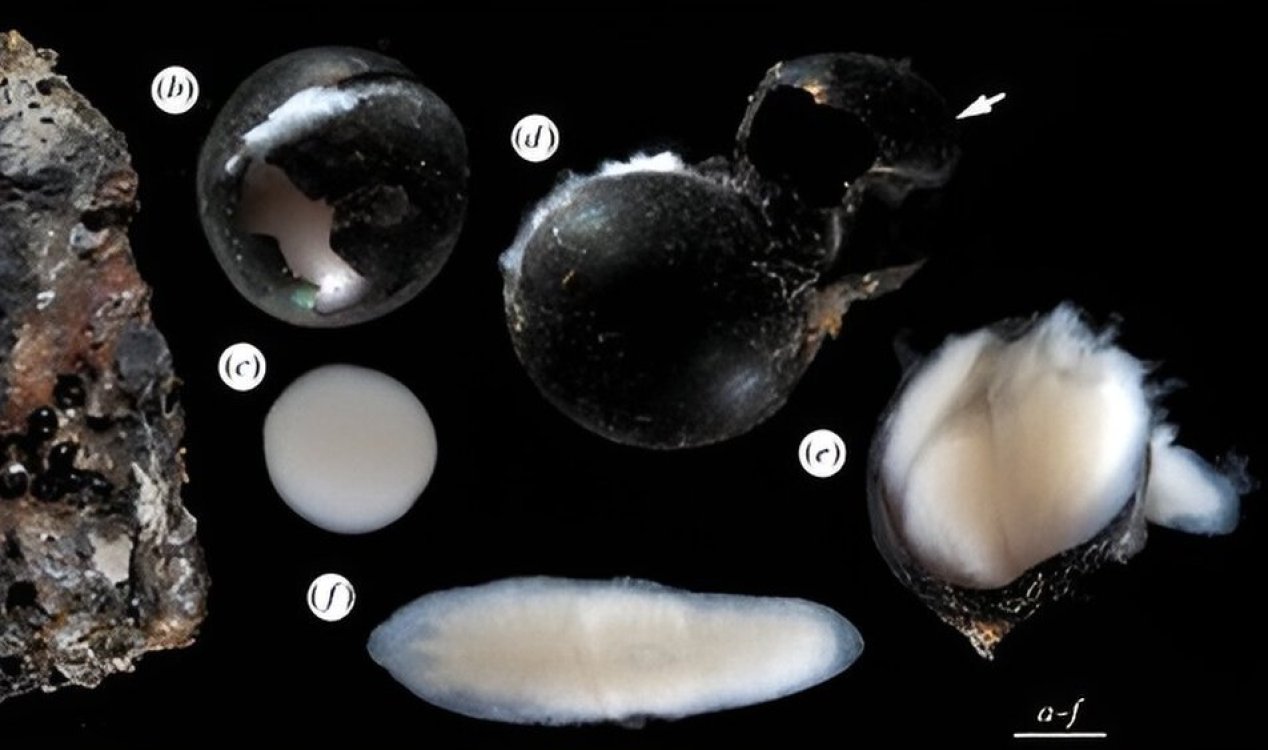Nature & Environment
February 8, 2024 · 1 comment
1 comment

Image Credit: Biology Letters (2024). DOI: 10.1098/rsbl.2023.0506
In particular, it has become apparent that life forms can eke out an existence in environments that had previously been considered completely uninhabitable.
This latest discovery of a clutch of strange black eggs situated at the bottom of a trench 3.7 miles beneath the northwest Pacific is yet another example of how life can surprise us.
At a glance, these small black spheres might look a bit like something out a science fiction horror movie, but when researchers at the University of Tokyo in Japan used a remote-operated submersible vehicle to retrieve some of the objects and bring them back to the surface, it turned out that these were in fact the first evidence of flatworms found at such extreme depths.
"When we opened the egg capsules, a milky liquid ... that might have been yolk was observed along with the flatworms," wrote Hokkaido University invertebrate biologists, Keiichi Kakui and Aoi Tsuyuki.
DNA analysis determined that these were a previously unknown species closely related to more common types of flatworms more typically found in shallower environments.
"This study provides the deepest record for free-living flatworms and the first information on their early life stages in the abyssal zone, which were very similar to those in shallow-water forms," the researchers wrote.
Source: Science Alert | Comments (1)
Scientists discover weird black eggs 3.7 miles beneath the ocean's surface
By T.K. RandallFebruary 8, 2024 ·
 1 comment
1 comment
Image Credit: Biology Letters (2024). DOI: 10.1098/rsbl.2023.0506
The discovery provides further proof of life's ability to thrive in extremely deep, high-pressure environments.
The number of undiscovered species that exist down in the depths of the Earth's deepest oceans seems unimaginable, yet slowly but surely scientists have been piecing together a slice of what life in the abyss is actually like.In particular, it has become apparent that life forms can eke out an existence in environments that had previously been considered completely uninhabitable.
This latest discovery of a clutch of strange black eggs situated at the bottom of a trench 3.7 miles beneath the northwest Pacific is yet another example of how life can surprise us.
"When we opened the egg capsules, a milky liquid ... that might have been yolk was observed along with the flatworms," wrote Hokkaido University invertebrate biologists, Keiichi Kakui and Aoi Tsuyuki.
DNA analysis determined that these were a previously unknown species closely related to more common types of flatworms more typically found in shallower environments.
"This study provides the deepest record for free-living flatworms and the first information on their early life stages in the abyssal zone, which were very similar to those in shallow-water forms," the researchers wrote.
Source: Science Alert | Comments (1)

The Unexplained Mysteries
Book of Weird News
AVAILABLE NOW
Take a walk on the weird side with this compilation of some of the weirdest stories ever to grace the pages of a newspaper.
Click here to learn more

Support us on Patreon
BONUS CONTENTFor less than the cost of a cup of coffee, you can gain access to a wide range of exclusive perks including our popular 'Lost Ghost Stories' series.
Click here to learn more
United States and the Americas
Israel, Palestine and the Middle-East
Modern Mysteries, New Age and Prophecies
Palaeontology, Archaeology and History
Total Posts: 7,768,013 Topics: 325,014 Members: 203,759
Not a member yet ? Click here to join - registration is free and only takes a moment!
Not a member yet ? Click here to join - registration is free and only takes a moment!



































Please Login or Register to post a comment.